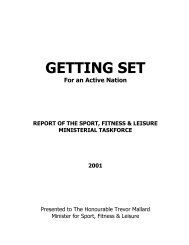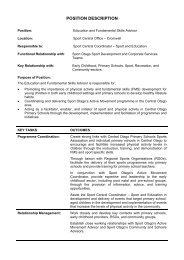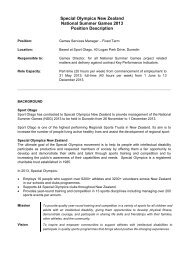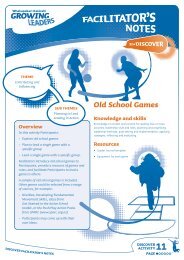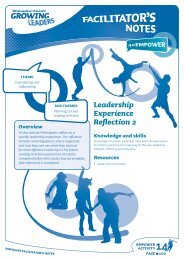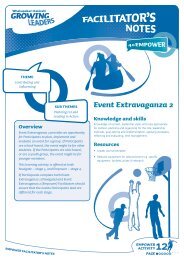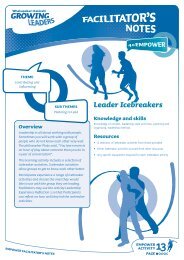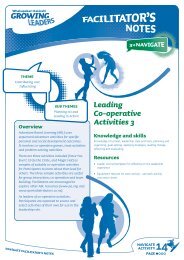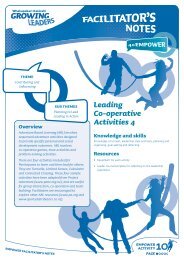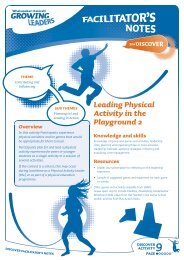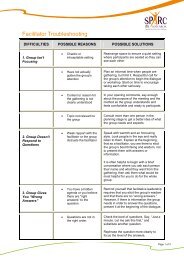Active Listening - Sport New Zealand
Active Listening - Sport New Zealand
Active Listening - Sport New Zealand
You also want an ePaper? Increase the reach of your titles
YUMPU automatically turns print PDFs into web optimized ePapers that Google loves.
vv vvavv<br />
THEME<br />
Connectedness<br />
SUB THEMES<br />
Relating to & Communicating<br />
with Others<br />
Overview<br />
Hearing and listening are not the same thing.<br />
People speak at 100 to 175 words per minute<br />
(WPM). People can listen intelligently at 600<br />
to 800 WPM. Therefore because only a part<br />
of our mind is paying attention during a<br />
conversation, it is easy to go into mind drift<br />
and think about other things while listening<br />
to someone. The cure for this is active<br />
listening – which involves listening with a<br />
purpose. It requires that the listener attend<br />
to the words and the feelings of the sender for<br />
understanding. It takes the same (or more)<br />
amount of energy than speaking.<br />
In this learning activity Participants complete<br />
a group activity with blindfolds on. They<br />
have to focus on active listening to complete<br />
the task.<br />
<strong>Active</strong> <strong>Listening</strong><br />
Knowledge and skills<br />
Knowledge and understanding of others, communication<br />
with others.<br />
Resources<br />
• Blindfolds<br />
• 15m long string/rope<br />
NAVIGATE FACILITATOR’S NOTES<br />
NAVIGATE9<br />
ACTIVITY<br />
PAGE
Blindfold Polygon<br />
IN A GROUP<br />
• One team leader is nominated<br />
• All members of the team (excluding the team leader)<br />
are blindfolded<br />
• Each member (excluding the team leader) must be holding<br />
the string, which is 15m long<br />
• Under the team leader’s instructions the team is to try<br />
to form a polygon shape based on the number of team<br />
members e.g. five members = pentagon, eight<br />
members = octagon<br />
• The team leader can instruct what to do and how to do<br />
it, however they are not allowed to touch any member<br />
of the team<br />
• A time limit will be set to judge how effective and efficient<br />
the team leader is<br />
ACTIVITY EXTENSION<br />
• To increase the challenge of ‘active listening’, the team<br />
decides on a means of communication that the team leader<br />
must use as their only means of guiding the team to form<br />
a polygon<br />
• The team leader must not speak words or touch any<br />
team members<br />
• Students usually come up with a system of noises such as:<br />
»<br />
»<br />
»<br />
»<br />
»<br />
One clap means walk forward<br />
Two claps means walk backwards<br />
Whistle means stop<br />
Click means turn right<br />
Cluck/Cluck means turn left<br />
• Students then swap roles and a new team leader<br />
is nominated<br />
“Form a triangle!”<br />
9 NAVIGATE<br />
ACTIVITY<br />
NOTES<br />
PAGE NAVIGATE FACILITATOR’S
NAME<br />
<strong>Active</strong> <strong>Listening</strong><br />
1. How well did your team complete the polygon?<br />
2. What did you use to communicate with each other?<br />
3. What other non-verbal clues helped you to complete<br />
the polygon?<br />
4. What can you do so that you can keep concentrating<br />
(not drifting off) when people are talking to you?<br />
5. What are the benefits of active listening?<br />
NAVIGATE LEADER JOURNAL<br />
NAVIGATE9<br />
ACTIVITY<br />
PAGE



